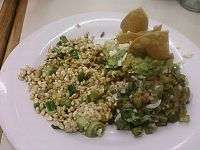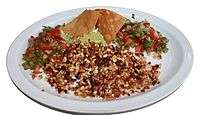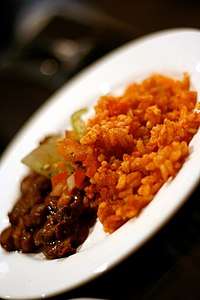Escamol
Escamoles (Spanish: [eskaˈmoles] (![]()
 Escamoles cooked in butter
Escamoles cooked in butter Escamoles al mojo de ajo
Escamoles al mojo de ajo
See also
- Chahuis — the edible beetles of Mexico
- Entomophagy — the human consumption of insects as food
- List of delicacies
References
- Reyes Castillo, Pedro and Enrique Montes de Oca. "Fauna". In Enrique Florescano, ed. (1997). El patrimonio nacional de Mexico (in Spanish). I. Fondo De Cultura Economica USA. pp. 179–180. ISBN 978-968-16-5452-8.
- Émile Bergier (1953). Peuples entomophages et insectes comestibles: Étude sur les moeurs de l'homme et de l'insecte (in French). N. Boubée. p. 152.
- DeFoliart, Gene R. "Insects as food". In Vincent H. Resh; Ring T. Cardé, eds. (2009). Encyclopedia of Insects. Academic Press. p. 381. ISBN 978-0-08-092090-0.
- Gaso, M.I. et al. "Biological monitoring of radioactivity and metal pollution in edible eggs of Liometopum apiculatum (ants) from a radioactive waste site in central Mexico". In Peter Warwick, ed. (2003). Environmental Radiochemical Analysis II. Royal Society of Chemistry. pp. 334–335. ISBN 978-0-85404-618-8.
- Anthony DePalma (2001). Here: A Biography of the New American Continent. PublicAffairs. p. 268. ISBN 978-1-891620-83-6.
- Ramos-Elorduy, Julieta and José Manuel Pino Moreno. "El consumo de insectos entre los aztecas". In Janet Long, ed. (2003). Conquista y comida: consecuencias del encuentro de dos mundos (in Spanish). Universidad Nacional Autónoma de México. pp. 89–90, 94. ISBN 978-970-32-0852-4.
- Cox, Lauren (May 4, 2010). "Top 5 Disgusting Delicacies". ABC News. Retrieved August 19, 2014.
External links
- Club 700 Hoy video on the harvest of escamoles (in Spanish)
- Julieta Ramos-Elorduy (1998). Creepy Crawly Cuisine: The Gourmet Guide to Edible Insects. Inner Traditions – Bear & Company. pp. 105–110. ISBN 978-0-89281-747-4. (Several recipes for escamoles.)
This article is issued from Wikipedia. The text is licensed under Creative Commons - Attribution - Sharealike. Additional terms may apply for the media files.


.jpg)
